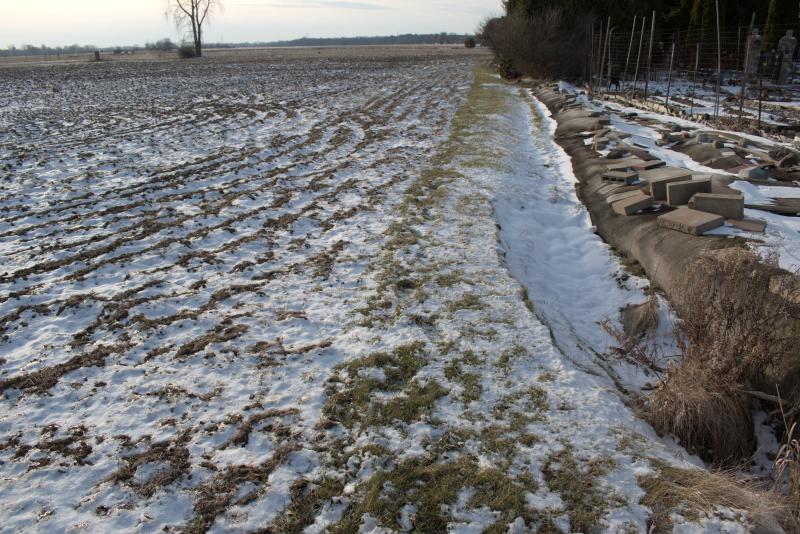Water
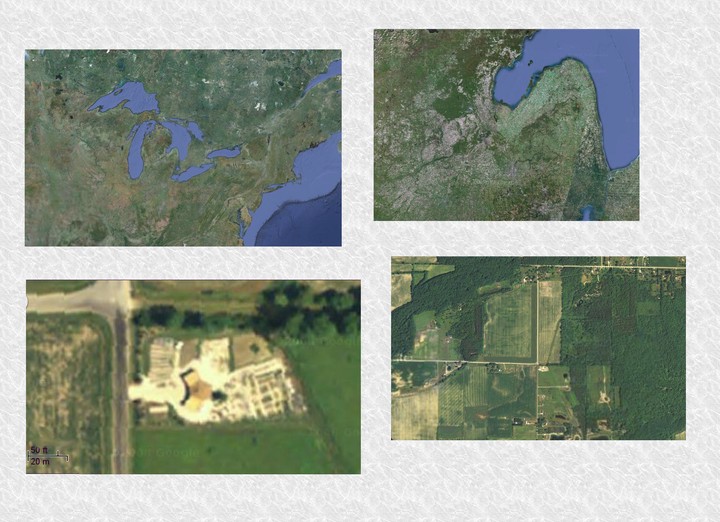
We are surrounded…
TABLE OF CONTENTS
- PRERAMBLE, GEOGRAPHY, GEOLOGY, RAINFALL
- TOPOGRAPHY, HISTORY
- DITCHES AND DRAINS
- SEPTIC DRAINFIELD AND WELL
- THE NORTH DIVERSION
- THINKING IN LAYERS, WATER CATCHES, SEEPS, BERMS
- THE SOUTH BERM - WHEN WATER FLOWED UPHILL
- DRY SPELLS
- POSTRAMBLES
- POSTPOSTRAMBLES
PRERAMBLE, GEOGRAPHY, GEOLOGLY, RAINFALL:
As of Dec 14, 2024 Lake Huron is about 176.3 meters (578.41 feet) above sea level (ASL). Where we are located is about 182.88-184.70 meters (600-605 feet) ASL. Our area used to be an inland sea - it is now called the Saginaw River Valley. The Saginaw River flows into the Saginaw Bay of Lake Huron - that is about 50 kilometers (30 miles) from here to the North East.
Michigan is a land of many lakes yet our county is the only one that has no natural large lakes. Think of those distances just mentioned and how little slope there must be to get from here to the big lake… We lose about half of the elevation nearby (a half mile away where the river elevation is 179.83 meters or 590 feet ASL) much before our local river enters a large wetland preserve called the Shiawassee Flats. Plenty of geese and ducks around and it isn’t unusual to have herons in the larger ditches.
A few hundred years ago most of the area was probably swampy woodlands dominated by white pines and oak trees in the areas that didn’t get too wet. After being “settled” in the 1800s most of the area was logged and drained for agricultural uses. The soil is sand, sandy loam, clay or clay with some sand mixed in (we have clay with a little sand) - glacial till, in places they have plenty of well rounded rocks. I’m not sure how far down to bedrock it is.
Our rainfall is about 10cm per month on average. In the colder times of winter that falls as snow. We do have a microclimate being in the valley - places to the west, north and south of us get more rain and we are far enough from Lake Huron that it is rare for lake effect snows to reach us.
TOPOGRAPHY, HISTORY:
The surrounding area here is pretty flat. If there wasn’t the river running nearby there would hardly be any difference at all.
The broader topography of the area is this flat river valley, old inland sea and perhaps being run over by glaciers a few times too may have contributed to how level it is here. The following picture is an elevation map which shows our area on the right side in the darker green.
Wider Topography -
Dec 14 2024 (1545K)
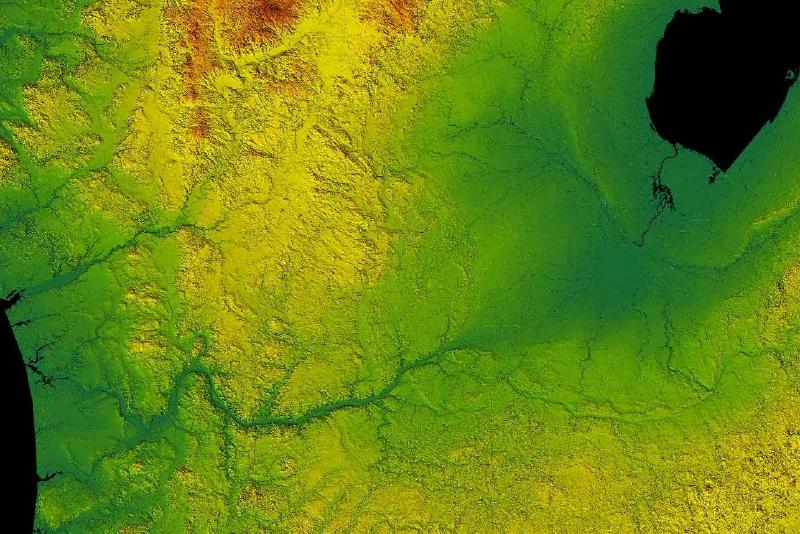
If you notice towards the middle and left there is a ravine showing where it looks like the Maple River (which connects to the Grand River) and the Bad River (which connects to the Saginaw River) might be able to be connected. In the 1838-1839 they supposedly started working on such a canal, but it was never finished. Some remnants still remain visible (but I personally have not seen them - someday I should see if I can find them. This would be worth a visit to the local Historical Society sometime). The canal was called the Saginaw and Grand River Canal or the Northern Canal and Bad River Canal. You can find a further description via The American Canal Society webpage for Michigan and it notes that the information may not be accurate or current, but at least it gives more than what I’ve typed here.
https://americancanalsociety.org/canals-of-michigan/
Here’s the details on our lot with the elevations in feet.
Close Up Topography -
Dec 14 2024 (658K)

And then we get to the various drains that were put in including ones that I added later (and of course more pictures down further).
Topography Main Flows -
Apr 6 2017 (723K)

Large and medium drainage channels around the property and along the road.
- Green: Overall Flow through the area (topography)
- Dark Blue: Two Major Drainage Ditches
- Light Blue: Road Ditches
Our little corner is 61 x 122 meters or 0.74322 hectares (200 x 400 feet = 80,000 square feet or 1.83655 acres). There are two large ditches through the property and another smaller ditch along the road. The two larger ditches run almost all year. It takes a very long extended dry spell for them to get to where they are not running much at all. What this also means is that our well water is not salty (unlike many people in the area), but it does contain some iron and calcium. We usually have plenty of ground water and not far down at all, in the spring anywhere from 30-50cm may come up wet enough to puddle. Only during longer dry spells can I do any deeper digging and in this clay it can be nearly as hard as cement.
The property was purchased as a temporary summer home artist studio/gallery and there was no plan to garden and for that reason they never brought in extra fill for the back area. There also wasn’t any planning for dealing with the drainage or water flows through the property. They had to have fill brought in for the septic drain field out front and is only area that also had much in the way of decent topsoil put over it which was then gradually sloped towards the ditches in the back and along the north.
The road along the north part of the property has one culvert through it for the two large ditches. With the second drainage ditch also flowing into it before the culvert you can see there is a bottle neck there. Whether intentional or not this can present problems at times of heavy rains or prolonged wet spells. However, we are not in danger of flooding the house itself even if there is some flash flooding of the lower areas out back. The elevation around us is so flat that it would take major amounts of rain to bring the entire area up several feet above grade to be a problem [below are some pictures of various water events].
DITCHES AND DRAINS:
Note: I am using the word ditch as an open to the air drainage channel and the word drain is a buried tube (sometimes perforated to let water seep in) to move water with less erosion.
The field to the south was left alone for many years - the runoff was fairly clean. Without much to worry about there was only one ditch needed in the middle of the back to be an outlet for the house footing sump pump (in the crawl space) and the fenced garden area. Once the field was put back into use for crops it created a lot more concerns for us (muddy water flowing over the crushed limestone mulch and various sprays/fertilizers used on the field) - especially considering I’d just spent the previous five years not using such things on the gardens. Luckily, we did not have many really strong rain storms before I could try to block and divert the flow.
Being here during spring melts and a few really heavy rains did show me what I needed to change. The simple things I could do quickly got done first like leveling and replanting to prevent erosion and stop a gully from forming that was getting started or putting in some extra drains in the gardens. In the fenced area though it was a bit of a problem because to put drains in there meant running a few lines right along the property line along the fence digging those in and then I had to fill it all back in and build it up to get the blocking berm over those drain tubes. Of course, doing all of this after the gardens were in place made the whole process much harder. Nothing could be done by machine. Working in clay made it quite fun for mud pies. The high water table or various ground springs make any project a challenge and more than once I had a trench almost done to have a heavy rain come along and the clay would slump and fill it in again.
Ditches and Drains -
Feb 20 2017 (836K)
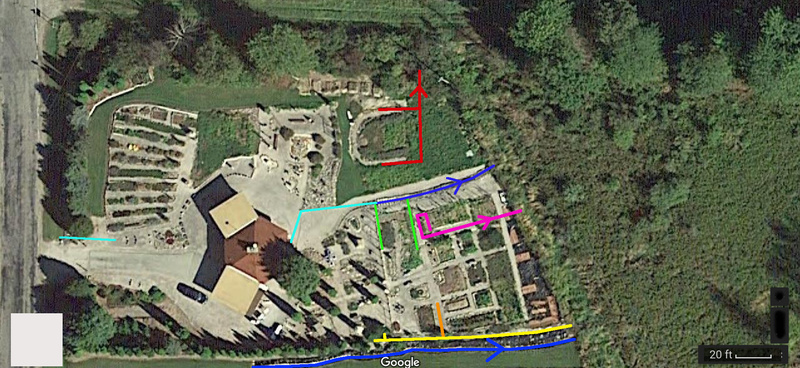
Initial Ditch and Drains
- Dark Blue (in the middle): Back Ditch
- Light Blue:
- House Drain
- Front Drain
- Green: First and Second Garden Drains (SE_Garden aka Fenced Gardens)
More Recent Ditch and Drains
- Red: Horseshoe Drain (N_Garden and NE_Garden)
- Pink: Raised Area Tulip Gardens and Lilly Garden Drain (SE_Garden)
- Orange: Main Path Drain (SE_Garden)
- Yellow: Double Drain (under a berm along S Edge of SE_Garden)
- Dark Blue (along bottom): South Ditch aka The River Nile
SEPTIC DRAINFIELD AND WELL:
The septic drainfield needed enough fill brought in to work properly given how much clay is here and how high the water table can get at times. The picture above with the ditches and drains shows the front gardens laid out in stripes for perennial flowers and that is where the septic drain field is at. The well is almost opposite along the south edge (near the propane tank and swing). I try to soak water in the ground in between those two things to keep any longer term chance of contamination of the well from being a problem. I think that the ground water flow prevents this too, but I don’t mind making it more sure.
THE NORTH DIVERSION:
Controlling erosion is important to me - I want to keep those organic materials, nutrients and topsoil in place as much as possible. The North Garden was always a problem as a sloping garden (from the higher area where the septic drainfield is at down to the normal grade of the back) because at times during heavy rains the flows from the house and front would erode away the dirt along the edge of the limestone mulch and it often caused troubles in the garden itself even if I did have a low area set aside to capture and soak in some of the water. As it also happened there was horsetail spreading along that edge that needed to be gotten rid of (It is still not completely gone many years later). I wanted a water catch that would not get full of weeds and that would release water gradually onto the lower area next to the birdbath. The work in progress…
Diversion Under Construction -
Aug 19 2011 (765K)

And the water catch in action…
Water Catch -
Apr 9 2013 (196K)
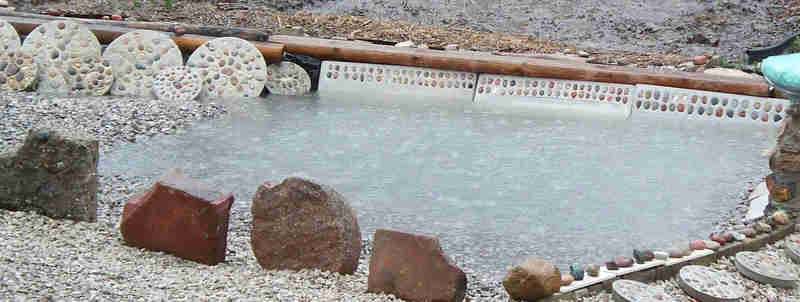
A bonanza of bricks meant I could replace the wooden pieces with bricks and it sure does look much nicer now…
Redone With Bricks -
Jul 11 2017 (1518K)

THINKING IN LAYERS, WATER CATCHES, SEEPS, BERMS:
For the N_Garden and NE_Garden.
The north water catch and diversion was only one part of landscaping the north side of the gardens. The ditch in the middle of the property handled the flows from flash floods across the gardens and any remaining low waters would soak in. That was ok with me, but none of those things dealt with the water and erosion that was going on to the north and north east when we had heavy rains. I started thinking in layers. Where could I capture the flow from a few cm (1 inch) rain? Then where could I capture what would come from a 6cm (two inch) rain? Then what?
The first Layer was the water catch described above. There were some low areas at the bottom of the North Garden left for some water loving low growing plants and a place where I could put some chunks of bark to keep some worms busy (previously it would only grow weeds so this was a good use of that low spot besides being used to capture some water and any soil washed down the slope). I also put in another water catch (seep, soak or swale are other common terms used for these along the side of the Flood Plain. These are all working as intended.
The second layer was much easier. I just needed to raise up the lip of the flat area where most of the water was already going to hold it back a little longer.Thus it became called The Flood Plain. If I wanted to hold back even more water it wouldn’t take that much to build it up even a bit more.
Flood Plain -
Apr 9 2013 (280K)

The next layer was easiest of all, as it was already there as a grassy strip that water had to go across to get to the Horseshoe pathway. You can see I really did need the drains put in…
Horseshoe Underwater -
May 13 2010 (783K)

With all the layers in place those drains don’t get used nearly as much as they did before.
THE SOUTH BERM - WHEN WATER FLOWED UPHILL:
Now back to that south field with water coming across our back gardens. The farmer who was using that field made a few efforts to keep it drained but mostly he just made what I’d already done keep working. Yet it wasn’t working very well…
South Field -
May 13 2010 (641K)
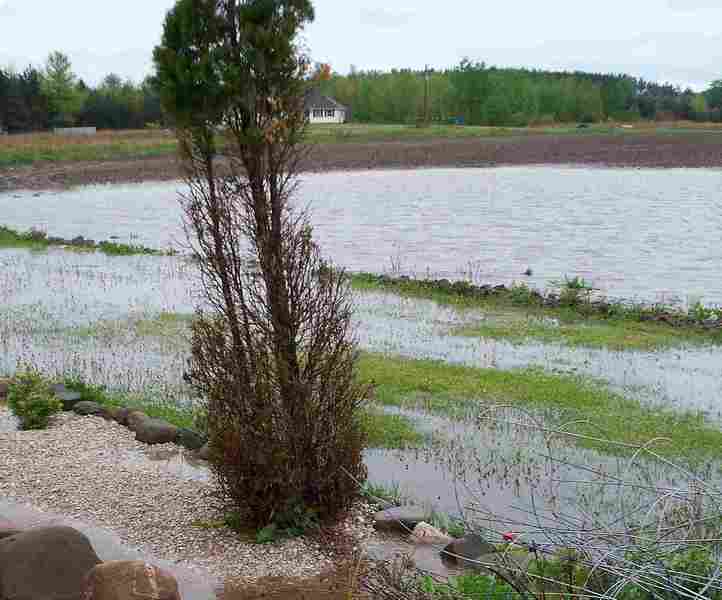
You can see that little line of dirt which was the first small berm and ditch I put in there to try to keep some of that water and dirt back. And also you can see how well it didn’t work. I really didn’t think it would but at least it made the farmer very aware of how little it would take to fix the problem. I didn’t think it would be nice to the neighbors to really dig up their property.
I was planning on putting a berm in anyways because they did restart farming the south field. The issue was made more urgent when we had a lot of rain over one day to soak the ground and then the next day we had a real downpour (the two day total was close to 28cm (11 inches) of rain). At one point the water in the front ditch along the road was flowing uphill (to the south) to go around our lot. I had a good laugh when I saw that! A once in 20 year event…
Kayak Weather (12:29pm) -
Aug 10 2012 (429K)
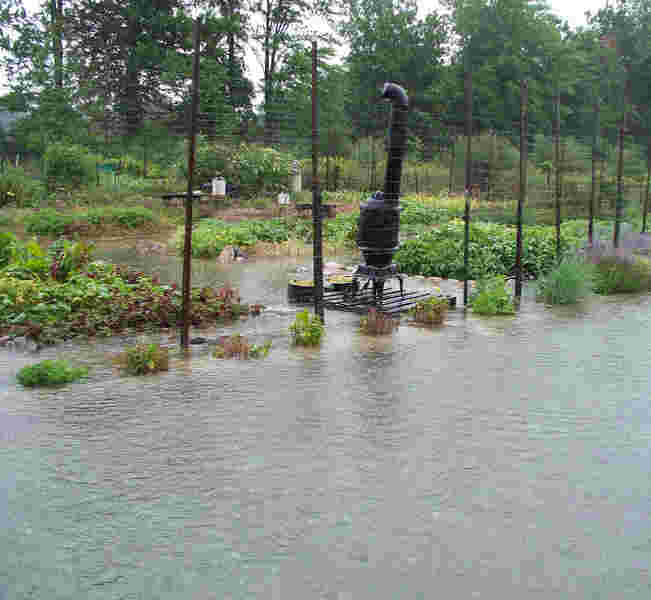
Kayak Weather (1:29pm) -
Aug 10 2012 (216K)
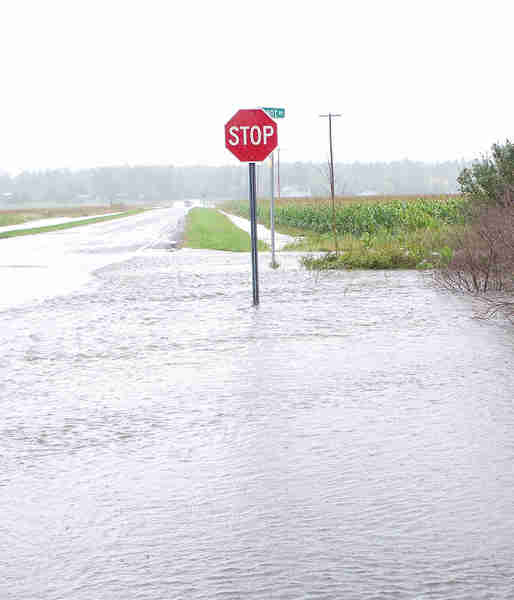
Kayak Weather (1:35pm) -
Aug 10 2012 (285K)

Kayak Weather (5:46pm) -
Aug 10 2012 (351K)
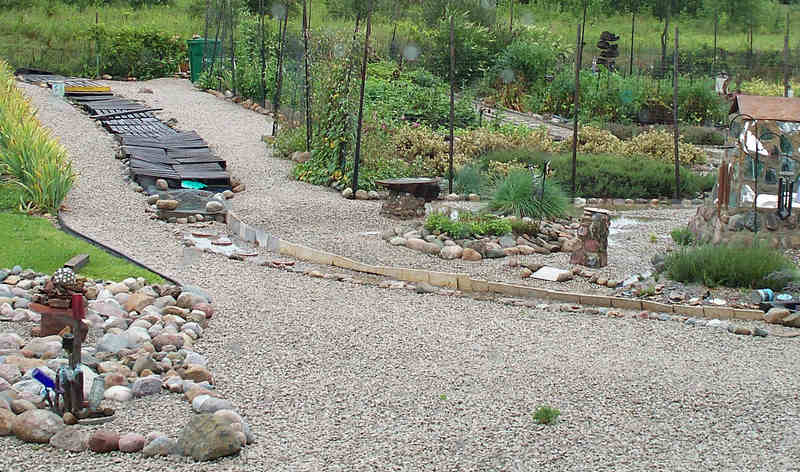
It wasn’t going to be a minor project to put that berm in (it is long and dug by hand). If I was going to block water coming across I also needed drainage for the low areas behind the berm (the fenced gardens and along the path getting to the gardens). I put in one good pathway drain in the fenced gardens which used the two drains I put in along the south edge. The two drains had to be dug out and then put down and then filled back in and then the berm could be put over them (the property line is close to that edge that I couldn’t have both the drains and the berm spaced apart - yes, that would have been much easier!). One of those drain tubes I put in I was hoping to use as part of a separate water catch overflow for the center area of the project but later on that plan was changed so it is extra capacity or a backup drain in case the water gets over the berm.
I hoped to work on this to have it sloped gradually and then planted so that it could still be mowed when it wasn’t wet. That plan was also changed and so the ditch remains as I initially put it in and the edges are gradually collapsing in and being over grown. The ditch is gradually sloped so it doesn’t erode. It was meant to be done in steps and grasses replanted to catch any dirt that may run off and at a gentle enough slope that it could all be mowed.
Ditch and Berm -
Oct 30 2013 (463K)
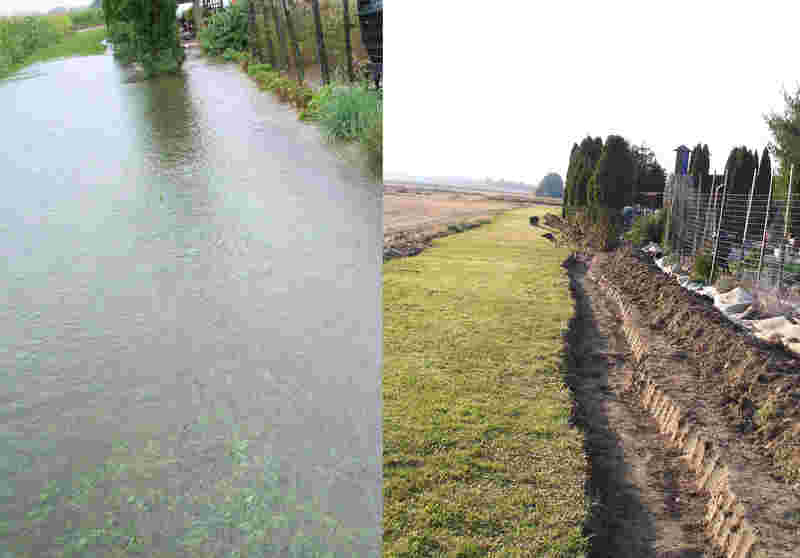
Our alternative name for the South Ditch is The River Nile.
DRY SPELLS:
Once in a while we go through some extended time of droughts and the large ditches/drains will slow in their flows, but it is rare that they dry out completely. The spring of 2023 is hot and dry rather early in the season. There’s an easy spot to see where the two large drainage ditches come together. I don’t know the exact acreage of each drain but I’m estimating it at about a square mile each. The flow directions in the picture are from the Top (South) to the Bottom (North) and from the Right (West) to the Left (East) for the drain coming from the Right (West). For reference to give a scale the right branch is flowing about a foot across and only a few inches deep. Combined I doubt they are both flowing more than a gallon or two per second. You can see from the bare area that they usually flow much more than they are in this picture. The deer hoof prints are a nice decorative touch.
Two Ditches Meet -
Jun 09 2023 (4255K)

Continued lack of rains meant the flow kept decreasing and I wondered if either branch would go completely dry. I kept an eye on them - close but not quite.
Low Flow -
Jun 25 2023 (4302K)
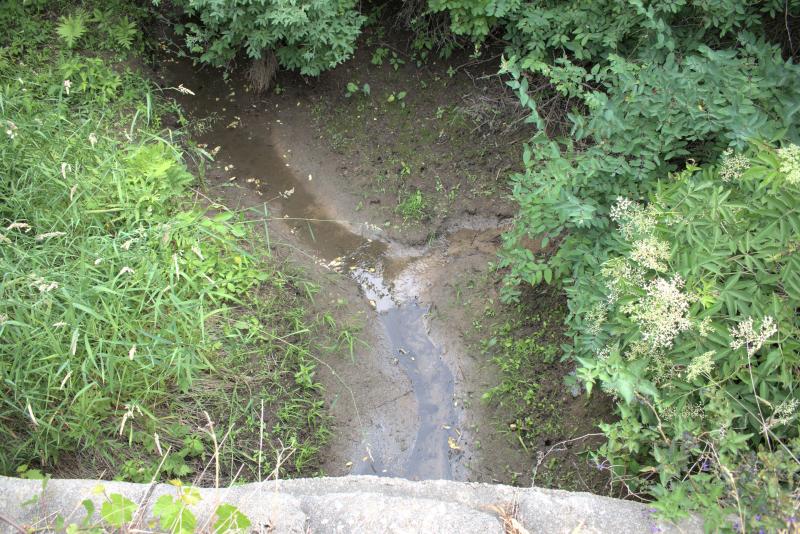
You would think that a few gentle rains of not more than two inches (5cm) would have been soaked up and not run off, but this shows that this land does not hold water as well as I would expect. The right (coming from the west) drain is slightly cloudy (it always has been slighty to mostly cloudy after rains due to drain tiles being installed in the farm fields, this shows that nutrients are being lost by using drain tiles). The south drain usually runs pretty clear and with tannins showing it is either filtering the water really well or not many drain tiles are being used in the farm fields that are using it (I do know that the fields on this part are more covered and not often left bare).
After Rains -
Jun 27 2023 (4288K)

More rains really improved the flow and I was glad to see a more normal level.
Much Better -
Jul 14 2023 (4196K)
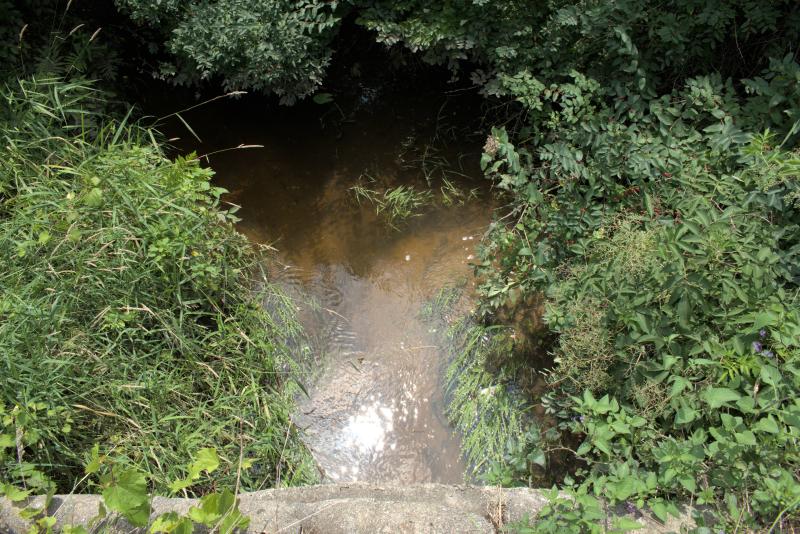
POSTRAMBLES:
We eventually had enough rain and snow to give the River Nile and the various features a little bit of a challenge. I went out and took a few pictures to remind me of where the water was flowing the most. When I get back to this area I can adjust the low spots to slow and spread the water even more. The perspective in the picture does not make it easy to determine the scale - the grass filter strip is 3 - 5 meters across and the distance that water is flowing over the grass filter strip is about 30 meters. I was glad to see the water running clear.
Small Test -
Apr 6 2017 (942K)
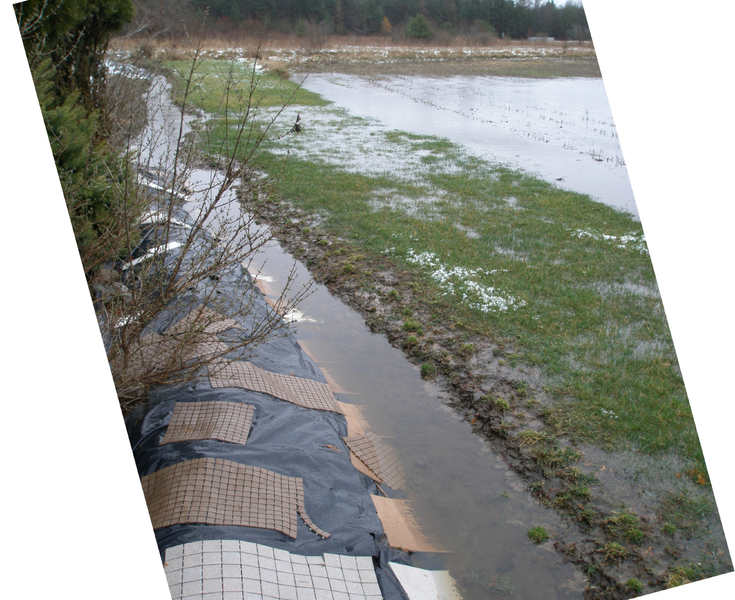
Then a year later and finally we had a pretty good rainstorm of about 5 inches of rain during the morning. You can see the low spots in the pathways and why we need raised bed back there, the strawberry patch which I lowered, but now I see that was a bit too much too low and the berm being put to work.
Path Low Spots -
Jun 27 2018 (1568K)
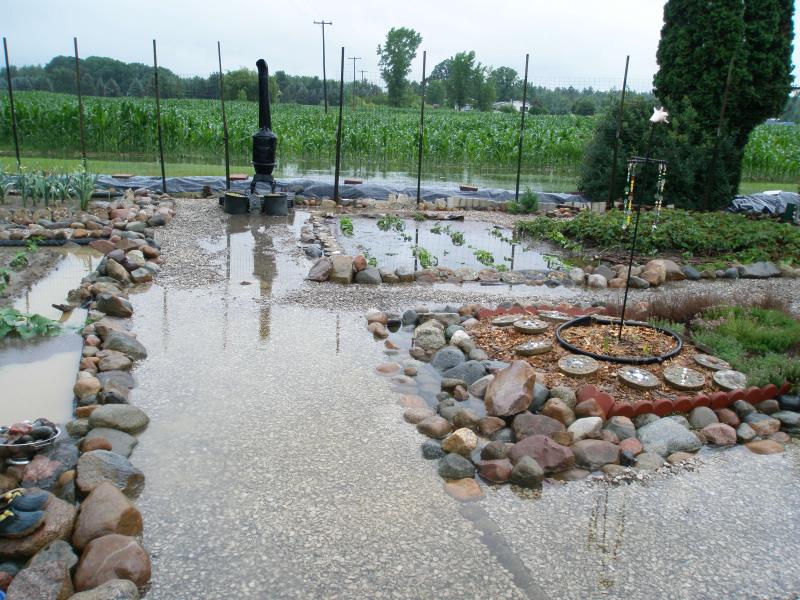
Too Low -
Jun 27 2018 (1545K)
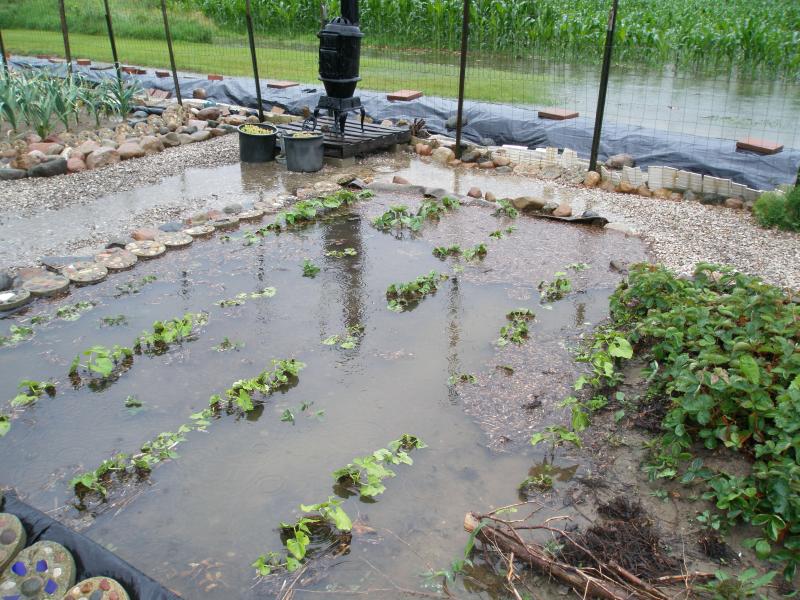
Berm At Work -
Jun 27 2018 (1568K)

It has been quite some time since I’d posted anything new on this topic, but we had a good gully-washer the other day so I had to go out in the rain and tromp around in the water and see how things were doing. I actually expected worse…
Mainly I wanted to check that the berm was doing what it should be doing and it was. Note the water is really clean as it runs off from the neighboring southern feild because they did not plow it last fall so the cover grass and weeds that are growing there did their job and held the soil in place.
The Berm -
Apr 05 2023 (4163K)
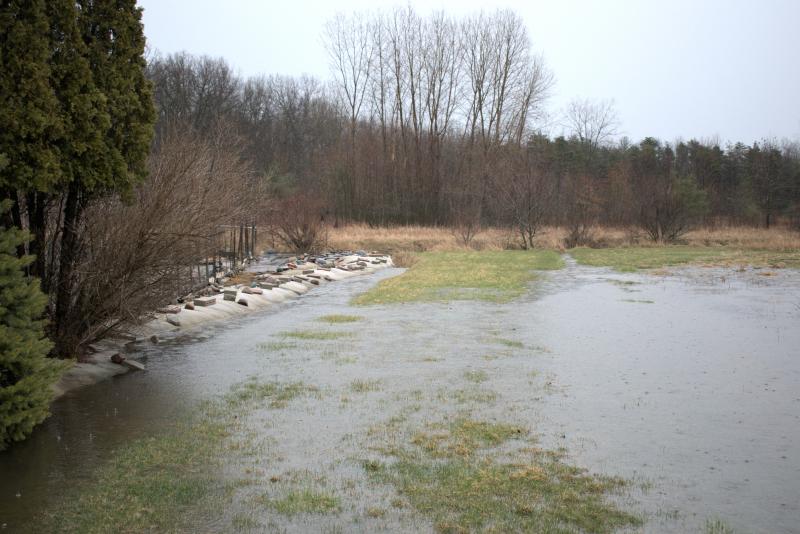
I also expected there to be more erosion of the River Nile which I did some work on last summer to shore up the erosion cut and to try to cushion the landing area and cover it with some large slabs so it would not get worse. It looks like it is holding up, but I also hope this summer to finally get it dealt with so it won’t continue eroding. I do like how the grass filter strip is working and the berm too so we’re on to dealing at last with the erosion issue which has been going on for quite a few years and simply put it is my fault for what it has become. Luckily it is pretty solid clay and does not erode nearly as easily as it would if it were more sand.
The River Nile Flowing -
Apr 05 2023 (4097K)

Just in case we get really flooded out still have the Light House. Yet the chances of such a big flood are remote because the 500 year and 100 year flood maps don’t even get close to here.
Lighthouse -
Jul 10 2016 (1404K)
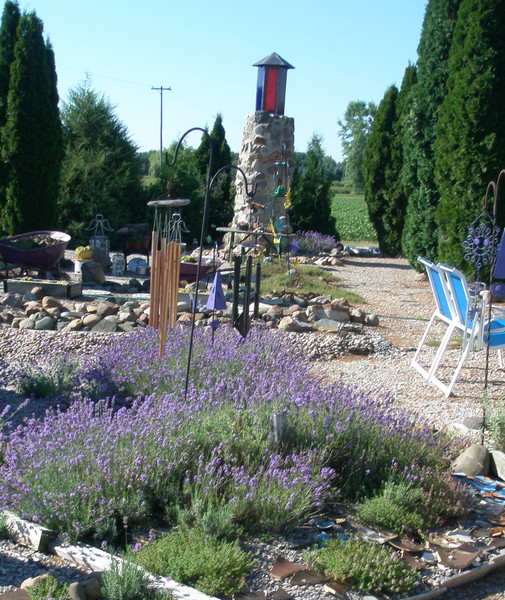
POSTPOSTRAMBLES:
I checked out the revised end of the River Nile to see how it was doing after I reshaped it some and moved some clumps of grass to fill it in. It didn’t look like we’d had enough rain to have any flows going through it which is really good because that lets the grasses I moved get more established and better anchored. I will likely continue to work on filling it in and adding more clumps of grass now that the field to the south is being replanted and put into a conservation easement. The wider I can spread out the flow the better it will be and I really want to be able to mow that area once in a while.
South Field -
Dec 14 2024 (4262K)
